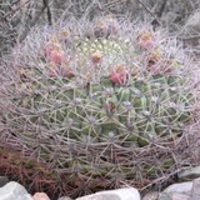Las plantas introducidas constituyen una de las amenazas más grandes que enfrenta la biodiversidad natural de Galápagos. Desde el primer momento en que la gente colonizó el Archipiélago, las personas han introducido plantas y animales... more
Las plantas introducidas constituyen una de las amenazas más grandes que enfrenta la biodiversidad natural de Galápagos. Desde el primer momento en que la gente colonizó el Archipiélago, las personas han introducido plantas y animales intencionalmente para alimento, medicina, madera también como mascotas y para ornamento; además algunas especies han sido introducidas accidentalmente. De las aproximadamente 850 especies de plantas introducidas que están presentes en Galápagos, cerca del 60% son ornamentales. Algunas de éstas ya han escapado de los jardines y se han convertido en un problema, otras están esperando para hacerlo. Muchas de las especies de plantas nativas de Galápagos son atractivas y muy adecuadas para ser parte de un jardín ornamental; sin embargo se usan raramente porque son desconocidas por la gente. Una medida positiva y proactiva para ayudar a la protección de Galápagos de futuros problemas es incentivar a la gente a plantar especies nativas en sus jardines en luga...
Estrategias para la erradicación de 21 especies de plantas potencialmente invasoras en Galápagos.
Research Interests:
Research Interests:
Research Interests:
Research Interests: Lebanon, Iran, Genetic Diversity, Portugal, Molecular Ecology, and 25 moreBiological Sciences, Phylogeny, Range Expansion, Europe, Wasps, Animals, DNA sequence design, Long Range, Quercus, Population Density, Iberian Peninsula, Population Growth, Oak, Spatial Distribution, Spatial Pattern, Genotype, Ecosystem, Isoenzymes, Genetic Divergence, Mediterranean region, Eastern Mediterranean, Dispersed Generation, Host Plant, Allele Frequency, and DNA sequence
Calandrinia galapagosa (Portulacaceae), is a critically endangered endemic plant from San Cristóbal Island, Galapagos. The species is threatened by goat herbivory and less than 1300 individuals remain, in nine populations. Three of these... more
Calandrinia galapagosa (Portulacaceae), is a critically endangered endemic plant from San Cristóbal Island, Galapagos. The species is threatened by goat herbivory and less than 1300 individuals remain, in nine populations. Three of these populations have been fenced to protect them from herbivory. However is not known whether these three populations are representative of the species. In addition, the species also shows 3 distinct color morphs and there has been speculation that these may represent different taxonomic units. This study uses AFLP markers to determine the genetic structure of the species, both by population, and by color morph. All nine populations were analyzed with a total of 189 specimens representing three different phenotypes. The analysis, based on 113 polymorphic AFLP markers, revealed low differentiation within populations and across phenotypes, and no correlation of geographic and genetic distance. These results indicate regular gene flow between populations a...
Research Interests:
Research Interests:
Research Interests:
Research Interests:
Research Interests: Zoology, Lebanon, Iran, Genetic Diversity, Portugal, and 27 moreMolecular Ecology, Biological Sciences, Molecular, Phylogeny, Range Expansion, Europe, Wasps, Animals, DNA sequence design, Long Range, Quercus, Population Density, Iberian Peninsula, Population Growth, Oak, Spatial Distribution, Spatial Pattern, Genotype, Ecosystem, Isoenzymes, Genetic Divergence, Mediterranean region, Eastern Mediterranean, Dispersed Generation, Host Plant, Allele Frequency, and DNA sequence
Research Interests: Genetics, Geography, Polymorphism, Population Dynamics, Genetic Diversity, and 18 moreMolecular Ecology, Biological Sciences, Molecular, Phylogeny, Range Expansion, Wasps, Movement, Haplotypes, Animals, Oak, Latitudinal Gradient, Glacial Refugia, Cytochrome B, Mediterranean region, Genetic variation, Base Sequence, Bayes Theorem, and Likelihood Functions
Research Interests:
Research Interests: Evolutionary Biology, Genetics, Heredity, Genetic Diversity, Phylogeny, and 16 moreMitochondrial DNA, Range Expansion, Europe, Wasps, Haplotypes, Female, Animals, Polymerase Chain Reaction, Wolbachia, Oak, Glacial Refugia, Cytochrome B, Isoenzymes, Genetic variation, Demographic History, and Base Sequence
Diverse human activities are modifying the global distribution of biodiversity (Sala et al., 2000; Chapin et al., 2001). Under-lying this phenomenon are two main processes that determine species richness, extinctions and biological... more
Diverse human activities are modifying the global distribution of biodiversity (Sala et al., 2000; Chapin et al., 2001). Under-lying this phenomenon are two main processes that determine species richness, extinctions and biological invasions (Vitousek et al., 1996), the rates of ...
Research Interests:
Research Interests:
... M. Trueman (&) 4 R. Atkinson 4 A. Guézou Charles Darwin Foundation, Puerto Ayora, Galapagos, Ecuador e-mail: mandy.trueman@fcdarwin ... highlands were the focus of all early human settlement due to the availability of water making... more
... M. Trueman (&) 4 R. Atkinson 4 A. Guézou Charles Darwin Foundation, Puerto Ayora, Galapagos, Ecuador e-mail: mandy.trueman@fcdarwin ... highlands were the focus of all early human settlement due to the availability of water making agriculture possible (Watkins and Oxford ...
Research Interests:
Research Interests:
Scalesia affinis is a threatened shrub endemic to the Galapagos archipelago. Its population on the island of Santa Cruz is critically endangered, with only 71 adult plants known. The future of these individuals is unclear due to imminent... more
Scalesia affinis is a threatened shrub endemic to the Galapagos archipelago. Its population on the island of Santa Cruz is critically endangered, with only 71 adult plants known. The future of these individuals is unclear due to imminent development of land surrounding the ...
